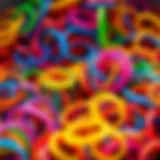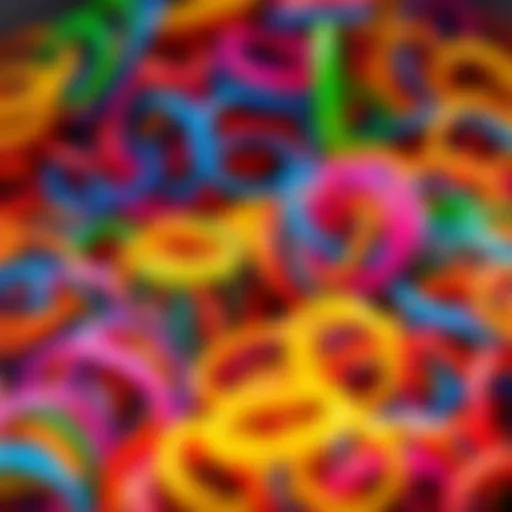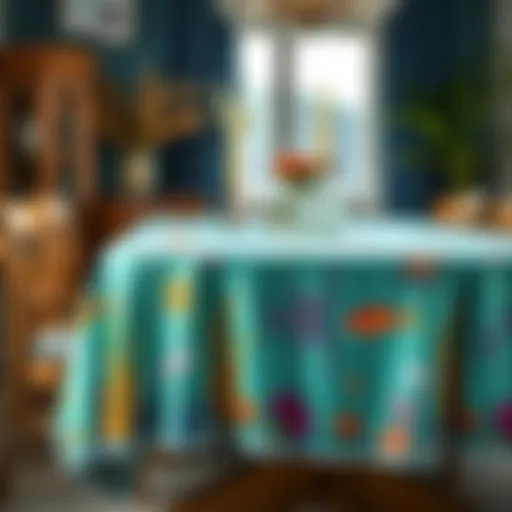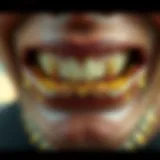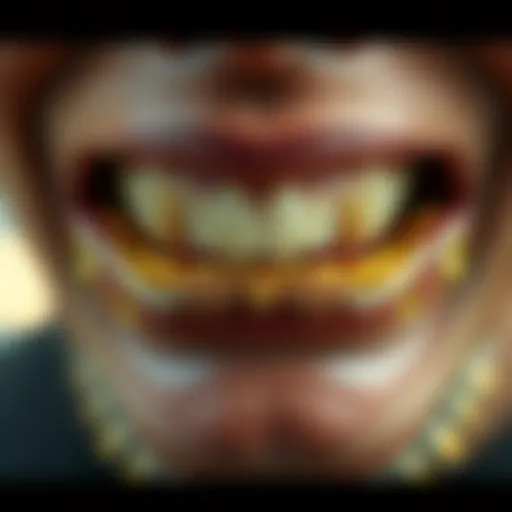The Influence of Urban Print in Fashion
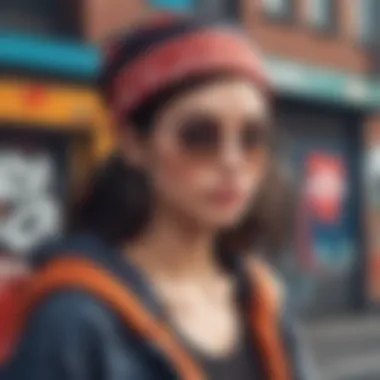

Intro
Urban print in fashion is more than mere aesthetics; it tells a story of culture, resilience, and expression. This beginning offers a glimpse into how urban print has evolved over the decades, merging with street styles, societal movements, and even the latest technology. As we navigate through this article, prepare to uncover the intricate layers of meaning behind urban prints, as well as their significance in the broader context of the fashion industry. Each stitch, every color, and pattern serves a purpose, reflecting the pulse of urban life.
As we delve into this dynamic realm, it’s crucial to understand two foundational aspects: cultural roots and the technological advancements shaping contemporary designs. Urban print often draws inspiration from the streets, representing lived experiences and communal narratives that resonate with many.
We shall also explore how urban styles find their way into haute couture and everyday fashion, shaping identities, both personal and collective. Hold on tight as we embark on a journey through the streets and into the catwalks, revealing the styles that make urban print a captivating and crucial part of the fashion language.
Fashion Trends
Current Trends in Clothing
Urban print is not just a seasonal fad. It has permeated various aspects of contemporary clothing, from casual wear to high fashion. The current scene reflects a vibrant tapestry of influences. Oversized silhouettes, bold graphics, and eye-catching colors define today’s trends. Think about a loose-fitting t-shirt adorned with large, abstract designs that mirror the graffiti seen in metropolitan areas. The rawness of urban life blends seamlessly into high-street fashion, proving that versatility is key in modern clothing.
Fashion enthusiasts are finding satisfaction in mixing tailored pieces with urban-inspired prints, creating looks that honor both sophistication and casualness. This art of blending styles opens up unique interpretations of identity and aesthetics.
Seasonal Attire Suggestions
When it comes to seasonal attire, urban prints offer an array of choices. For instance, during spring, lightweight jackets with intricate floral or geometrical prints can breathe life into a wardrobe. Paired with well-fitted jeans or chinos, such combinations radiate an effortless charm. Similarly, in the winter months, consider layering with vibrant hoodies featuring urban graphics under structured coats. The play between casual and formal wear allows many to express themselves while staying comfortable.
Key Factors of Trend Utilization
- The integration of sustainable materials in urban print designs is becoming a necessity, reflecting increased global awareness.
- Increasing consumer demand for authenticity has pushed designers to tell their own stories through prints.
"In fashion, urban print acts like a mirror to our society, reflecting both style and substance.”
Style Tips
How to Mix and Match Outfits
Navigating the world of urban print can seem daunting, but with a few style tips, it becomes an exciting endeavor. Start by selecting a statement piece—maybe a boldly printed shirt or a pair of decorated sneakers. From here, neutral tones can help balance out the look. Pair that vibrant shirt with dark jeans or a classic black jacket for an effortlessly chic vibe.
Experimenting also plays a crucial role here. Don’t shy away from clashing prints. Stripes, polka dots, and abstract designs can coexist if balanced correctly. Remember, urban fashion celebrates individuality, so let your creativity shine.
Essential Wardrobe Staples
Incorporating urban print into your wardrobe doesn’t require a complete overhaul. Instead, focus on adding a few key pieces:
- A graphic tee featuring street art or a pop culture reference.
- A pair of joggers with urban flair, comfortable yet stylish.
- Sneakers that easily transition from day to night while showcasing artistic designs.
- Oversized accessories like bags or caps that act as conversation starters.
By aligning these essential items together, your style can tell a story of urban exploration and personal expression. Each choice reflects not just fashion sense but an engagement with cultural dialogues and societal reflections.
Prelims to Urban Print
The world of fashion often reflects the vibrantly chaotic pulse of urban life, and if there's one element embodying this essence, it’s urban print. These bold, lively designs evolved from cityscapes, capturing the spirit and sentiment of the streets. Urban print isn’t just a trend; it’s a narrative of our societies, a means through which wearers can express their identities in parts and parcels, stitched together by their backgrounds and daily experiences.
Definition and Scope
Urban print refers to the unique patterns and designs derived from the interplay of contemporary city life. It can encompass everything from graffiti art to the textures found in urban architecture, which transform into compelling fashion statements. These prints often emerge from the fine line between art and everyday culture, thus making fashion a canvas for self-expression.
Key Elements of Urban Print:
- Cultural Influence: Shaped largely by street arts and community leader's visuals, urban print showcases cultural trends.
- Diversity of Aesthetics: With roots weaving through backgrounds, every urban print tells a different story.
- Versatile Applications: Seen on everything from high-end runway designs to accessible streetwear, urban prints reach a wide audience.
Historical Evolution
The history of urban print is as rich as the cities they originate from. Initially, these prints can be traced back to communal artwork on walls, where street art served as a protest, as communication, or simply as a form of personal expression. Over time, these visuals migrated into fashionable garments.
Major Milestones in the Evolution of Urban Print:
- 1970s-80s: The graffiti movement came about, influencing not only the art scene but also fashion design. Think of the iconic works of Jean-Michel Basquiat, who merged street aesthetics with more traditional forms of expression.
- 1990s: Hip-hop culture brought urban print into mainstream fashion with brands like FUBU and Cross Colours.
- 2000s Onwards: A continual blend of high fashion with street styles emerged; houses like Louis Vuitton began collaborating regularly with street artists. This period marked urban print's undeniable place on the runway.
In recognizing the deep-rootedness of urban print in our society, we see it as a reflection of cultural movements, political expressions, and the everyday experiences of individuals. This exploration sets the stage for understanding the dynamic relationship between urban print and the fashion industry as we delve into the cultural dimensions next.
Cultural Dimensions of Urban Print
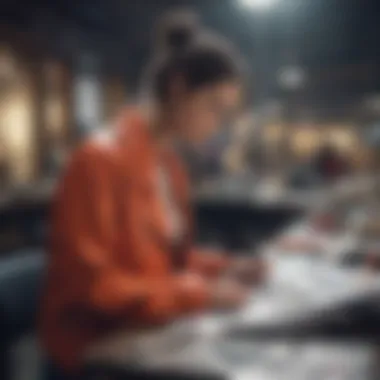

The cultural dimensions of urban print reveal the complex interweaving of societal values, street style, and artistic expression within the fashion realm. Urban print is not just fabric; it's a language, a statement, and often a lifestyle, reflecting the pulses of city life. When we dissect this topic, it becomes clear how deeply entrenched urban print is in cultural narratives, shaping not just individual identities but also collective experiences across different communities.
Influence of Street Culture
Street culture serves as the heartbeat of urban print; it defines the patterns, colors, and themes that echo through the fabric. The raw aesthetics found in tempestuously painted city walls or the lively scenes of crowded streets are often translated into clothing. Designers like Off-White and Supreme incorporate graffiti-inspired elements, making it clear that urban print draws from the vibrant essence of street life.
Street culture is characterized by its democratic nature, allowing individuals to express personal and group identities. This gives rise to styles that resonate with youth movements or local art scenes, making urban print a visual diary of sorts. It makes you wonder: how many folks really stop to think about the ideas dancing across their tees or jackets? The real power lies in the stories these prints tell.
Urban Print and Identity Formation
Urban print plays a significant role in how people forge their identities. It's not uncommon to see individuals curate their wardrobes in ways that speak volumes about who they are, where they’ve been, or what they believe in. From political graffiti to music labels, these prints can embody veteran pride or cultural heritage.
Moreover, the confluence of different styles and patterns across various urban environments leads to a beautiful amalgamation of identities. Think about hip-hop culture, where artists use urban bold colors and striking designs to communicate messages of struggle, resilience, and creativity. These choices are deliberate, reflective of deeper social contexts—marking every piece of clothing with stories that extend beyond fabric alone.
"Fashion is the armor to survive the reality of everyday life." - Bill Cunningham
Thus, urban print serves as a form of communication; an unspoken dialogue where patterns speak to the past while paving a path for future expressions.
Regional Variations
Not all urban prints are created equal. Different regions impart their unique characteristics onto prints, shaped by local culture, climate, and history. For instance, think about the intricate prints seen in African textiles, reflecting tribal heritage and community narratives, versus the bold, minimalist street styles from cities like Tokyo, where simplicity marries function.
Each urban setting throws its color palette and design ethos into the mix, creating an exciting convergence of influences. Here are some examples of regional variations:
- North America: Graffiti-inspired motifs dominate, reflecting socio-political issues, youth rebellion, and lifestyle culture.
- Europe: Textures and designs from street art often blend with haute couture, forming hybrids that convey luxury and grit simultaneously.
- Asia: A reimagining of historical and cultural themes through modern lenses, showcasing harmonic relationships between tradition and contemporary design.
These regional twists are essential when examining urban print; they contribute to a larger narrative on globalization in fashion, highlighting how local flavors can impact global trends.
In summary, delving into the cultural dimensions of urban print uncovers a multifaceted discussion worth having in the realm of fashion. As modern apparel evolves, so too does the dialogue around identity, culture, and community, urging us to reflect on our personal ties to the clothes we wear.
Design Elements of Urban Print
When it comes to the design elements of urban print, the intricacies blend creativity and functionality. These elements are not just for visual appeal; they mirror the soul of urban culture, encapsulating narratives that are often left untold. Each aspect—from the hues chosen to the materials utilized—influences how the urban print interacts with the environment and the individuals who don it.
Color Palettes and Patterns
Color plays a pivotal role in establishing the mood and feel of any urban print. Bold colors often capture attention, while softer shades may evoke a sense of nostalgia or subtlety. For example, the vibrant greens and blues used in street art can be found translating onto fabrics, embodying the spirit of the city. Consider this: a bright orange t-shirt adorned with zigzag patterns can represent the energy of a bustling market, while muted earth tones often reflect the gritty reality of urban landscapes.
Patterns also contribute to the dialogue between the wearer and their surroundings. Geometric shapes might signify modernity and innovation, drawing inspiration from architectural designs, while floral or organic patterns could hint at a connection to nature, even in a concrete jungle. Unique motifs are an effective way to tell a story or showcase cultural narratives; think of the tribal patterns that speak of heritage or social movements noted in urban environments.
Urban prints are an expression of identity, often breaking through conventional styles.
"In the urban landscape, prints don't just exist; they thrive, echoing the personalities of those who wear them."
This vibrancy and variety allow consumers to find pieces that resonate personally or communally. Additionally, blending these colors and patterns can create surprising effects, forging connections across various demographics. As people mix and match, they participate actively in what urban print represents—a canvas of communal experiences.
Material Choices and Textures
Materials used in the construction of urban prints play an essential role in defining their functionality and appeal. The choice of fabric contributes to the wearability, durability, and overall aesthetic of the garment. Cotton, with its breathable nature, is often favored for casual urban wear, while polyester can lend a shiny, modern finish that grabs attention during night scenes or club outings.
Textures also invite deeper engagement with urban print. A soft, distressed texture evokes a laid-back vibe, often mirroring the lived experiences of city dwellers. Alternatively, smoother textures can reflect luxury and high fashion, bridging the gap between street style and haute couture. One might see a collaboration where a design team incorporates leather patches or reflective surfaces into a classic streetwear hoodie, offering not only a new visual element but also a tactile interaction for the wearer.
The blend of these materials often tells stories about their origins. For instance, recycled fabrics can signify a growing consciousness around sustainability, resonating particularly well with today's eco-aware consumers. It’s about crafting an experience where the wearer becomes part of a larger narrative—one that's intertwined with sustainability, identity, and community.
Urban prints indeed rely on a harmonious balance of design elements, creating wearable art that reflects a wealth of influences and emotions. Each color, pattern, and texture encapsulates a facet of life in the city, transforming simple fabric into an emblem of personal and collective expression.
Urban Print in Haute Couture
Urban print often dances on the fine line between street style and high fashion, breathing new life into the haute couture world. This dynamic interplay makes the exploration of urban print in this realm particularly captivating. From its boldness to its rich cultural references, urban print serves as a powerful tool for designers who wish to evoke emotions and tell stories through their garments.
Urban print reinvents the very essence of haute couture. Traditionally associated with luxury and exclusivity, haute couture is now beginning to embrace the raw energy and vibrancy of urban aesthetics. Designers are increasingly incorporating bold motifs and diverse patterns that speak to a wider audience. The key benefits of this synergy are manifold:
- Cultural Connectivity: Urban print fosters a sense of belonging among individuals from diverse backgrounds. It provides a canvas for cultural expression, making high fashion more accessible and less elitist.
- Visual Narrative: Every print tells a story. Urban prints often reflect social movements, local artistry, and historic contexts, creating garments that resonate deeply with wearers.
- Innovation in Design: By integrating urban elements, designers are pushing the envelope. This encourages a fresh approach to craftsmanship and encourages exploration beyond conventional boundaries.
Yet, the incorporation of urban print in haute couture is not without its challenges. Considerations around the authenticity of representations and the voice of the communities from which these inspirations are drawn are paramount. The dialogue surrounding cultural appropriation reverberates through runways, urging designers to tread carefully.
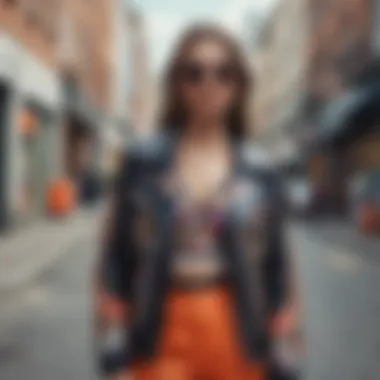

Runway Trends
The runway offers a grand stage where urban print takes center spotlight. Here, the evolution of current trends is undeniable. In recent seasons, designers have showcased their creations with striking prints that draw heavily from urban landscapes and local iconography.
- Geometric Shapes and Lines: Leading houses have utilized geometric motifs inspired by urban architecture. This approach not only modernizes couture but also connects to the often rigid and structured nature of urban life.
- Bold Color Combinations: An explosion of color is evident with vibrant hues pulled from graffiti art and urban murals. This color pop breathes life onto the runway, grabbing attention as models strut their stuff.
- Layering Techniques: Designers are experimenting with layering prints and textures, pushing the boundaries of what haute couture can be. The risk-taking involved here adds an unpredictable edge that reflects the spontaneity of street style.
Collaboration with Street Artists
One cannot explore the depths of urban print in haute couture without acknowledging the pivotal role of street artists. Many high-end designers are now forging collaborations with these creatives, bringing authenticity and grassroots talent into luxury fashion.
This collaboration often results in visually stunning collections that celebrate street culture while elevating it to new heights.
- Authenticity: Working directly with street artists gives designers a legitimate perspective and voice from the community. This authenticity resonates with consumers looking for genuine connections to their clothing.
- Unique Prints: Street artists bring a distinct style that melds street art with haute couture. This meeting of minds results in designs that are not just clothing but wearable art.
- Social Commentary: Pieces often embody social issues, reflecting broader discontent or narratives within urban society. Wearers become part of this conversation, making fashion an avenue for dialogue.
In summary, the blend of urban print in haute couture is an evolving narrative filled with opportunities and debates. The threads that connect these two worlds are woven with creativity, cultural significance, and a touch of rebellion.
Technological Influences on Urban Print
The intersection of technology and urban print in fashion cannot be overstated. The advances in digital printing and the surge of social media platforms have reshaped not only how urban prints are created but also how they are consumed. These developments foster new forms of creativity and allow young designers and established brands alike to reach audiences like never before. In a way, technology serves as a bridge, connecting street culture to high fashion through innovation and accessibility.
Digital Printing Advances
Digital printing technology has reached dizzying heights and fundamentally altered the fashion landscape. Unlike traditional print methods, which were expensive and time-consuming, digital printing allows for rapid production of designs. This efficiency empowers designers to bring their visions to a life nearly overnight, melding creativity with practicality. One standout aspect of digital printing is its ability to produce short runs, making it more feasible for emerging designers to experiment with bold urban aesthetics without breaking the bank.
- Precision: The accuracy of computer-driven printing ensures that intricate designs and vibrant colors maintain their integrity, which is essential in urban print.
- Customization: Beyond mere production speed, digital printing allows for individualized pieces, catering to consumers who appreciate one-of-a-kind items. People nowadays want styles that resonate with their personal narratives.
- Sustainability: It can be more environmentally friendly, as it reduces textile waste and water consumption compared to traditional methods. Brands are increasingly aware of their ecological footprint, and this technology provides a viable path towards greener practices.
These advances ensure that urban prints can adapt and flourish, reflecting the pulse of contemporary street culture without the constraints imposed by prior printing technologies.
Social Media Impact
Now let's chat about social media's role in the evolution of urban print. Platforms like Instagram, TikTok, and Pinterest have become fertile grounds for fashion influence. Urban prints, often infused with vibrant cultural references, thrive in these visual-centric platforms. They aren’t just trends; they are movements, often kick-started by grassroots online communities. With each like, comment, and share, urban print designs gain momentum.
- Diverse Voices: Social media democratizes fashion, giving underrepresented designers and artists a stage to showcase their work. This inclusivity leads to a richer tapestry of urban print designs, representing varied cultural narratives.
- Real-Time Feedback: Designers can gauge audience reactions swiftly, allowing for quicker pivots in style, color, or theme to align with consumer desires. It’s a dance, where brands and customers interact fluidly.
- Campaigns and Movements: Hashtags and viral challenges amplify messages, creating a hub for discourse around issues like sustainability and cultural appropriation. The conversation surrounding urban print often exceeds a simple aesthetic appreciation, diving deeply into cultural significance.
"In a world where trends come and go at the speed of social media, urban print serves not just as clothing, but as a reflection of our collective identity, influenced by the very platforms that connect us."
In a nutshell, both digital printing advances and social media have revolutionized urban print. They have paved the way for vibrant, sustainable, and culturally rich fashion narratives that resonate with today’s fashion aficionados. As the urban print scene continues to innovate, it remains an exciting domain for exploration in the world of fashion.
Sustainability and Urban Print
In recent years, the dialogue around sustainability has sparked a significant shift in various industries, including fashion. Urban print plays a vital role within this context, providing opportunities for innovation and responsible choices that address pressing environmental concerns. The fusion of sustainability and urban print reflects not just a trend, but a deeper commitment to ethical practices and environmental consciousness among consumers and designers alike.
The integration of sustainable practices in urban print signifies a conscious effort to reduce the fashion industry's ecological footprint. As urban print continues to represent the voice of diverse cultures through vibrant designs, its advent in eco-friendly materials and ethical crafting becomes essential. Addressing sustainability goes beyond aesthetics; it requires understanding the implications of resource use, waste, and labor practices. By choosing sustainable urban prints, consumers make statements that resonate beyond their wardrobes, further influencing the industry at large.
Eco-friendly Materials
When we talk about eco-friendly materials in the context of urban print, we highlight textiles that are environmentally safe and sustainable. This involves using organic fabrics like cotton or hemp, which are grown without harmful pesticides or chemicals. Another crucial aspect involves recyclable materials that minimize waste and encourage a circular economy. For instance, recycled polyester made from plastic bottles illustrates how urban print can creatively utilize what might otherwise end up in landfills.
Utilizing dyes and finishing processes that are less harmful to the environment is just as essential. Water-based inks have gained popularity for their reduced toxicity. Not only do these materials lessen pollution, they also often yield vivid colors that align with the bold style typically seen in urban prints. Here are some examples of eco-friendly materials:
- Organic Cotton
- Linen made from Flax
- Tencel (Lyocell)
- Recycled Polyester
- Natural Dyes
A recent report highlighted that switching to eco-friendly materials could reduce the fashion industry's carbon emissions by up to 30% over the next decade.
Incorporating these materials into urban print designs not only speaks to environmental responsibility but also caters to a growing audience of informed consumers who are increasingly mindful of sustainability.
Ethical Production Practices
The journey toward a sustainable future in urban print involves more than just material selection; it also encompasses the ethical production practices behind the scenes. Understanding the labor conditions under which urban prints are created is fundamental to evaluating their sustainability. Ethical production implies fair wages, safe working environments, and respect for workers' rights. It acknowledges that fashion is not just fabric, but a web of human interactions.
Brands that embrace ethical production often underscore transparency, allowing consumers to track the origins of their garments. This transparency builds trust and empowers consumers to make informed decisions. Being aware of where and how a product is made highlights a brand’s commitment to social justice, which increasingly influences purchasing choices in the fashion marketplace.
Here are key components of ethical production practices:
- Fair wages for workers
- Safe working conditions
- Transparent supply chains
- Compliance with labor laws
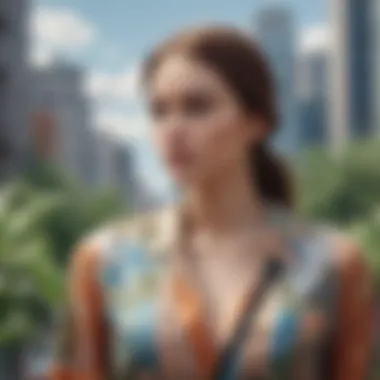

Focusing on ethical production complements the allure of urban print, allowing consumers to support brands that prioritize responsible and just manufacturing processes. Through a thoughtful blend of eco-friendly materials and ethical practices, the future of urban print can align with a healthier planet and a more equitable society.
Consumer Behavior and Urban Print
The intersection between consumer behavior and urban print in fashion serves as a compelling lens through which we can understand modern style choices. Urban print is not merely a trend; it resonates deeply with consumers' identities, offering a medium of expression that reflects their surroundings, attitudes, and cultural affiliations. By exploring how individuals engage with urban print, we can uncover insights that influence the way brands approach design, marketing, and overall consumer engagement.
Market Trends
The influence of urban print on market trends is substantial, shaping what consumers seek in their wardrobes. One key trend is the rise of streetwear, which encapsulates the essence of urban print through graphics, bold colors, and innovative patterns. This style, originating from urban environments, speaks to a younger demographic eager to showcase their individuality.
- Sustainable Practices: Increasingly, consumers are prioritizing brands that incorporate eco-friendly practices into their production. Urban print brands are responding, with designs made from organic materials and processes that minimize environmental impact.
- Limited Editions: The allure of exclusivity has gained traction. Limited-run collections featuring unique urban prints create a sense of urgency for buyers, triggering impulse purchases.
- Collaboration with Influencers: Social media influencers have become a significant force in shaping market trends. Their endorsement of urban print styles can catapult a product into the limelight, encouraging followers to adopt similar styles.
Trends aren't just confined to aesthetics; they encompass the values consumers hold dear. Brands that align urban print with social justice causes, inclusivity, or community building often find stronger resonance with their audiences.
Personal Style and Urban Print Adoption
The adoption of urban print into personal style highlights the dynamic relationship between an individual’s taste and the cultural narratives surrounding them. Here, we see how city life can dictate fashion choices in profound ways. Urban print allows individuals to embrace aspects of their environment and incorporate them into their personal narrative.
For many, wearing garments adorned with urban prints is akin to wearing a badge of honor that signifies connections to local culture and identity. The acceptance and enthusiasm for this style often depend on the following factors:
- Cultural Significance: Urban prints often stem from specific cultural movements or local artists, making them emotionally significant to the wearer.
- Affordability and Accessibility: Brands that produce urban print clothing tend to offer a wide price range, allowing various consumers to access these styles without burning a hole in their pockets.
- Versatility: Urban style prints can easily blend with everyday attire, making it appealing for various casual and semi-formal settings.
- Social Influence: Peer groups significantly impact style choices. When urban print trends become popular within a particular social circle, it can create a domino effect, encouraging more individuals to jump on board.
"Fashion is not just about wearing clothes; it tells a story. Urban prints knit together experiences, culture, and place into every thread."
In summary, the townscape and its artistic expressions flow into the design of urban prints, thereby feeding into how individuals cultivate their personal style. The implications of consumer behavior regarding urban print indeed underline a significant shift in fashion paradigms, merging art, culture, and individual expression more than ever.
Challenges and Criticisms
The discussion around urban print goes beyond mere aesthetics; it dives into complex issues surrounding cultural dynamics, market trends, and ethical considerations. Engaging in this topic is essential for a deeper understanding of how urban print shapes not just individual style but entire cultures. Addressing the challenges and criticisms associated with urban print helps fashion enthusiasts recognize the multifaceted implications of their choices in clothing.
In recent years, the intersection of fashion and culture has generated significant dialogue, and two focal points often surface: cultural appropriation and market saturation. These topics not only reveal essential tensions but also offer a lens through which to view the integrity of urban print in today’s fashion landscape.
Cultural Appropriation Concerns
Urban print frequently draws inspiration from various cultural motifs and styles. While this can lead to creative expression, it can also tread into murky waters. The appropriation of cultural symbols by fashion designers who don’t belong to those communities raises questions about authenticity and respect. Such acts can sometimes result in resentment among the original culture, especially if profit is generated without acknowledgment or appreciation of the source.
To illustrate, consider the case of the kente cloth, a traditional fabric rooted in Ghana’s history. When used out of context or purely for visual appeal in high-fashion settings, it may strip the fabric of its significance, rendering it just another trend. The conversation around this is crucial because it compels everyone—from designers to consumers—to reflect on their choices.
"Cultural appropriation isn’t just about using motifs; it’s about understanding where they come from and honoring their meaning."
This awareness has spurred conversations about the need for collaboration and respect. Designers are increasingly recognizing the value in partnering with artisans and creators from the communities they draw inspiration from. This shift not only addresses concerns over appropriation but also enriches the design process.
Market Saturation
Another pressing issue is market saturation. Urban print has gained immense popularity, but this very buzz has led to a flood of similar products in the retail space. When faced with an oversaturation of urban prints, consumers may feel overwhelmed by choice, diluted by the quality of offerings, and ultimately disillusioned.
As the market fills with print-heavy garments, brands risk failing to stand out and might result in a homogenization of style. Furthermore, larger fashion houses can sometimes dominate the urban print scene, overshadowing small designers who originally carved out niche markets. Fast fashion companies play a role in this as well, quickly reproducing urban print designs at lower cost, which can erode quality and authenticity.
To consider:
- Impact on small designers: Their unique approaches can be lost among mass-produced counterparts.
- Consumer fatigue: When every store window showcases similar designs, the novelty fades, and buyers may look elsewhere.
- Environmental concerns: Increased production in a saturated market often leads to closer scrutiny of sustainability practices in fashion.
Future of Urban Print
Urban print has come a long way since its humble beginnings, and as fashion continues to evolve, so does the significance of urban print within it. This section delves into the future of urban print, an essential topic for understanding how the ever-changing landscapes of culture and technology will influence fashion trends. The future of urban print encompasses innovative trends and cultural fusion, which will not only redefine street style but also challenge traditional notions of fashion.
Innovative Trends
As we look to the future, several innovative trends are on the horizon for urban print in fashion. One such trend is the increased use of augmented reality and virtual platforms in showcasing designs. Brands may create interactive experiences through apps, enabling consumers to see how urban prints look in various contexts. This innovation allows shoppers to visualize their style choices more vividly, effectively bridging the gap between the physical and digital worlds.
Moreover, sustainability will continue to play a pivotal role in shaping urban print. With growing awareness of environmental issues, designers are beginning to utilize eco-friendly materials and processes. For example, brands may increasingly turn to recycled fabrics or plant-based dyes that reduce harm to the environment. This eco-conscious approach resonates with a consumer base that demands not only style but also ethical production practices.
Additionally, advances in digital textile printing allow for designs to be created swiftly and customized easily. Consumers might find themselves able to personalize clothing with their choice of urban prints, tailoring pieces to reflect their exact tastes. This level of customization can lead to more meaningful purchases, fostering a deeper connection between fashion and personal identity.
"The future of urban print will not just be about the clothes we wear, but the story they tell about our culture and values."
Cultural Fusion in Fashion
Cultural fusion is enthusiastically reshaping urban print, which can be seen as a result of globalization and the accessibility of diverse art forms. As cultural boundaries blur, the blending of styles from different parts of the world generates fresh perspectives in fashion. Designers are tapping into various cultural heritages, incorporating motifs, patterns, and techniques that tell a more expansive story about identity and experience.
This cross-pollination of ideas brings forth a myriad of design collaborations that celebrate multiculturalism. Urban print will thrive in this environment, where designers draw inspiration not only from traditional street art but also from folklore and indigenous artistry. This fusion can add richness to urban print, leading to distinctive collections that break new ground.
Furthermore, global shifts in demographics are crucial in determining future trends. Younger generations, like Millennials and Gen Z, are keenly aware of their cultural heritage and enjoy blending it with modern aesthetics. As a result, urban print will likely feature increasingly diverse influences, bridging past and present while resonating with contemporary sensibilities.


